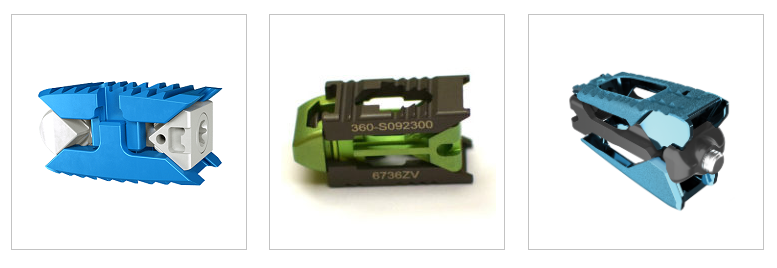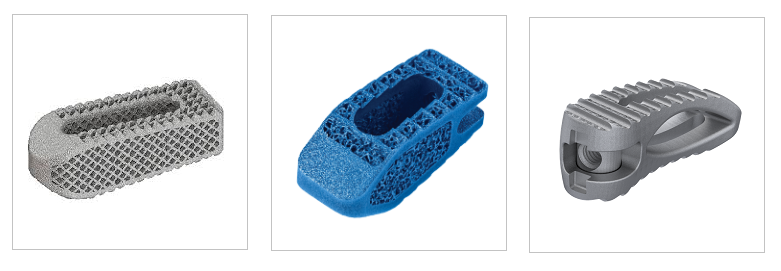According to Allied Market Research, the global interbody fusion cage market is projected to reach $2,309 million by 2023.The lumbar segment capture the highest share of about 30% and is expected to remain dominant throughout 2023.
The main trends in the Lumbar cages market are the following:
- Lateral and ALIF cages
- Stand Alone interbody fusion devices
- 3D printed titanium interbody spacers
- Expandable devices
These six PLIF/TLIF cages have already received U.S. Food and Drug Administration (FDA) 510(k) clearance or CE Mark approval . Most of them have started with the first surgeries or they will be launched during the next months.

1.- AccelFix-XT Expandable Cage System | Aegis Spine
In October 2019, Aegis Spine, Inc., an innovative subsidiary of L&K BioMed, announced FDA 510(k) clearance of the new AccelFix Expandable Cage. It was launched at the end of last year.
AccelFix-XT expandable cage system for TLIF and PLIF helps restore disc height, segmental lordosis, and stability while offering a customized fit for the patient’s unique anatomy.
In addition to realizing key benefits of lateral MIS surgery, such as minimizing blood loss, OR time, and hospital stay, AccelFix-XL has the potential to reduce psoas muscle retraction time, enhance surgical workflow, and unencumber hospitals from unnecessarily complex logistics and inventory models.
2.- eZspand™ Expandable Cage | Zavation Medical
On May 26, 2020 Zavation Medical headquartered in Flowood, MS, announced the launch of eZspand™, an expandable lumbar interbody fusion device.
eZspand™, the latest addition to Zavation’s portfolio, features unmatched expandable precision paired with continual expansion to provide an optimized fit for each patient. This optimized fit allows for enhancement of structural stability and improved sagittal balance. eZspand™ does not require secondary locking, minimizing procedural steps.
Each implant expands to 4.5mm from the insertion height to create a large graft window that facilitates fusion. The benefits of continuous height adjustment (not incremental) up to 4.5mm expansion paired with no secondary locking step separate eZspand™ from its competitors.
3.- SABLE™ | Globus Medical
On May 07, 2020, Globus Medical announced its financial results for the first quarter ended March 31, 2020 and also the launch of SABLE.
SABLE™ is an expandable posterior lumbar interbody spacer with 3D printed titanium endplates designed to minimize endplate disruption, maximize sagittal balance restoration, and optimize fusion with in situ graft delivery.
Features and Benefits:
- Minimize Disruption: SABLE™ may be inserted at a contracted height as low as 6mm to help reduce endplate disruption, nerve root retraction, and impaction forces.
- Maximize Restoration: SABLE™ provides up to 22° of lordosis and continuously expands up to 8mm to help restore sagittal balance and foraminal height.
- Optimal Fusion Environment: The 3D printed titanium endplates along with in situ graft delivery provide an optimal environment for fusion.

On February 4th, 2020, Osseus Fusion Systems announced the official Alpha Launch of Aries™-TS, its 3D printed transforaminallumbar interbody fusion device.
Aries™ devices are constructed from highly porous titanium material, which is optimized for bone fusion and biological fixation using PL3XUS, Osseus’ innovative and proprietary 3D-printing technology. PL3XUS titanium technology utilizes powder bed fusion, specifically Selective Laser Melting (SLM), to create 80% porous implants with increased bone graft packability and lower stiffness compared to competitive devices on the market. Aries™ implants are manufactured in 30-micron layers of titanium powder and sintered in solid, porous parts, in sequential layers.
The Aries™ implants then undergo a rigorous, proprietary post-processing cycle to optimize the device for clinical outcomes.
The Aries™ family of lumbar interbody fusion devices features a proprietary mesh lattice structure, which helps reduce the stiffness of the cage and maximize bone graft packability. The distinctive mesh structure is optimized to create a superior environment for bone cell fixation and proliferation. Each Aries™ lumbar interbody fusion device comes in a wide variety of footprints, heights, and lordotic angles, to adapt to a variety of patient anatomies.
5.- HEDRON P™ 3D Printed PLIF | Globus Medical
On May 07, 2020, Globus Medical announced its financial results for the first quarter ended March 31, 2020 and also the launch of HEDRON line of 3D printed interbody spacers
HEDRON™ spacers feature a biomimetic porous scaffolding designed for bone formation onto and through the implant. HEDRON P™ implants are available in a wide range of footprints and two lordotic profiles to fit individual patient anatomies and aid in sagittal balance.
Features and Benefits:
- The Face of Fusion:An ovine interbody study demonstrated significantly more bone ingrowth within HEDRON™ implants at 6 weeks post-op compared to PEEK and solid titanium implants.* Data on file
- Threaded Connection: HEDRON P™’s robust threaded design provides a secure connection during impaction.
- Radiographic Imaging: Clear imaging facilitates assessment of placement and fusion.
6.- UNiD® IB3D Patient-Matched | Medicrea
On February 24th 2020, Medicrea announced the FDA clearance for their UNiD® IB3D Patient-Matched interbody cages which will be added to their UNiD® Adaptive Spine Intelligence (ASI) platform.
The 3D-printed titanium implant is the first of its kind to offer such a wide range of customizability in regards to cage dimensions and endplate morphology.
The cages are designed using the UNiD® ASI pre-operative surgical planning tool to match the patient’s optimal anatomical requirements and take into account every patient’s unique endplates and vertebral bodies differences.
Features and Benefits:
- Expert Positioning: The IB3D™ TLIF-Banana is a unique 3D printed titanium implant designed to facilitate cage insertion and placement through a self-articulating mechanism.
- MIS Compatible:The system’s full range of implants are designed to be compatible with MIS technologies and techniques.
- Optimized Interface: Proprietary 3D Hexalock™ technology possesses rough titanium to elicit stability and bone fusion.
